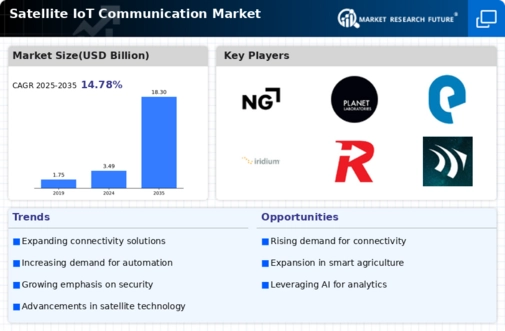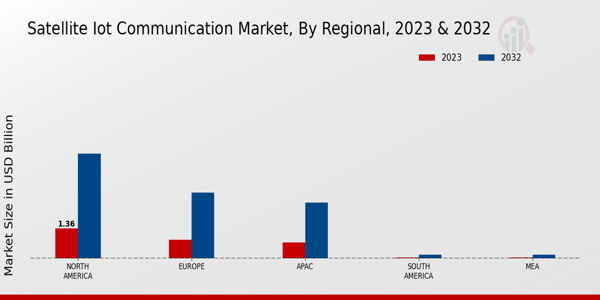Market Growth Chart
Expansion of Smart Cities
The rise of smart city initiatives globally significantly influences the Global Satellite IoT Communication Market Industry. Urban areas are increasingly adopting IoT technologies to improve infrastructure, enhance public services, and promote sustainability. Satellite IoT communication plays a crucial role in connecting various smart devices and systems, enabling efficient data exchange and management. For example, cities leverage satellite communication for traffic management, waste management, and environmental monitoring. This trend is likely to contribute to the market's expansion, with forecasts suggesting a substantial growth trajectory, potentially reaching 18.3 USD Billion by 2035, driven by the integration of satellite IoT solutions in urban planning.
Rising Need for Global Connectivity
The Global Satellite IoT Communication Market Industry is driven by the rising need for global connectivity, particularly in remote and rural areas where terrestrial networks are insufficient. Satellite IoT communication offers a viable solution for connecting devices in these hard-to-reach locations, enabling various applications such as environmental monitoring, asset tracking, and disaster response. For example, organizations are deploying satellite IoT systems to monitor wildlife and track natural disasters, ensuring timely responses. This growing demand for global connectivity is expected to propel the market forward, as industries increasingly recognize the value of satellite communication in enhancing operational capabilities.
Advancements in Satellite Technology
Technological advancements in satellite communication systems are pivotal to the Global Satellite IoT Communication Market Industry. Innovations such as low Earth orbit (LEO) satellites and enhanced data transmission capabilities enable more efficient and reliable connectivity for IoT devices. These advancements facilitate the deployment of IoT solutions in remote and underserved regions, where traditional communication infrastructure is lacking. For instance, companies are launching LEO satellite constellations to provide global coverage, thereby expanding the reach of IoT applications. This technological evolution is expected to bolster market growth, as it enhances the feasibility and attractiveness of satellite IoT solutions for various industries.
Growing Demand for Remote Monitoring
The Global Satellite IoT Communication Market Industry experiences a notable increase in demand for remote monitoring solutions across various sectors, including agriculture, energy, and transportation. As industries seek to enhance operational efficiency and reduce costs, satellite IoT technology provides an effective means of monitoring assets in real-time, regardless of location. For instance, farmers utilize satellite IoT devices to monitor soil conditions and crop health, leading to improved yields. This trend is expected to drive the market's growth, with projections indicating a market value of 3.49 USD Billion in 2024, reflecting the increasing reliance on satellite communication for remote applications.
Increased Investment in Space Infrastructure
The Global Satellite IoT Communication Market Industry benefits from increased investment in space infrastructure by both governmental and private entities. Governments are recognizing the strategic importance of satellite communication for national security, disaster management, and economic development. Concurrently, private companies are investing in satellite technology to capitalize on the growing demand for IoT connectivity. This influx of capital is likely to accelerate the development and deployment of satellite IoT solutions, enhancing their availability and affordability. As a result, the market is poised for robust growth, with a projected compound annual growth rate (CAGR) of 16.24% from 2025 to 2035, reflecting the increasing prioritization of satellite communication.






















